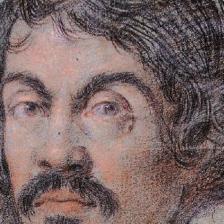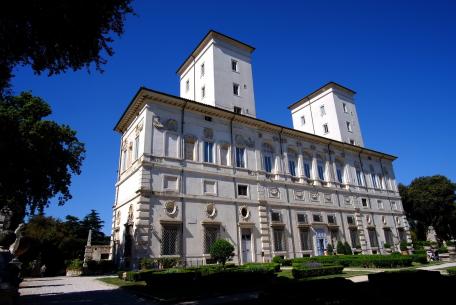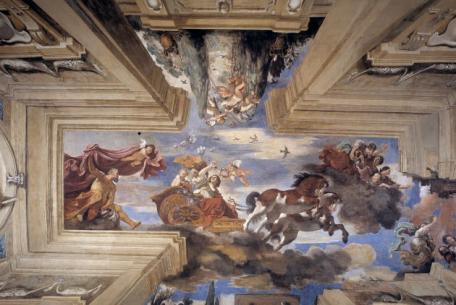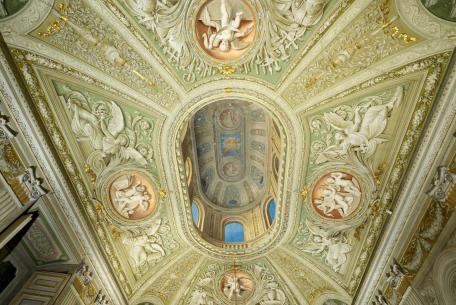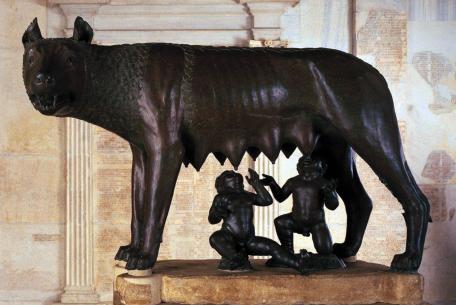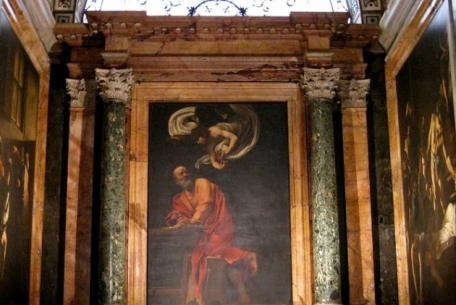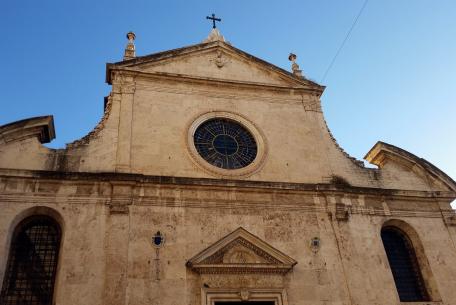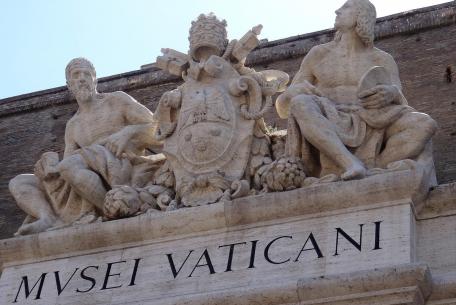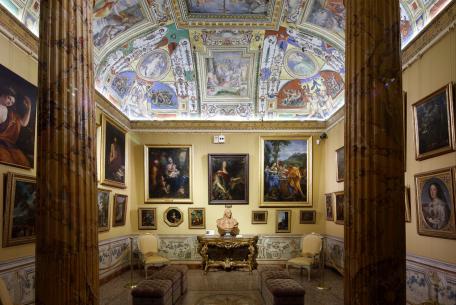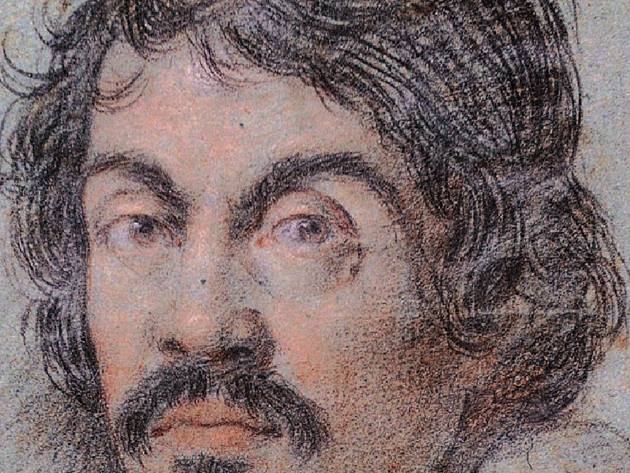
Michelangelo Merisi was born in Milan on 29th September 1571, on the day of Saint Michael the Archangel, from Fermo Merisi and Lucia Aratori. His father was responsible for the buildings belonging to the marquis of Caravaggio, a small village near Bergamo where Lucia came from and from which derives the nickname of the artist.
He started to work as a shop boy in the workshop of Simone Peterzano, a mannerist painter and pupil of Tiziano. Caravaggio’s arrival in Rome remains unknown, however there are documents proving that he was already in Rome in 1592. At that time, it was a must for the artists to work in the Eternal City which was crossed by great building and urban redevelopment. Ancient Basilicas were undergoing major reconstructions and Saint Peter’s Basilica was being completed. Caravaggio however, preferred to frequent taverns and slums. Cardinal Francesco del Monte noticed him while he was painting “flowers and fruits” in Cavalier d’Arpino’s workshop. Later, he would become his protector and would introduce him to the collectors.
The naturalism depicted in The Fortune Teller (1593-94) and in Young with a Basket of Fruit (1593-95) shows that Caravaggio’s way of painting is empirically based, accentuated by the use of the mirror as a “dark room.” Cardinal del Monte encouraged him and hosted him at Palazzo Madama. In 1600 he was commissioned his first important work, the decoration of cardinal Contarelli’s chapel in the church of Saint Louis of The French. Caravaggio painted the two side paintings of the chapel: The Martyrdom (1599-1600) and The Vocation of Saint Matthew (1599-1600) as well as the altarpiece, Saint Matthew and the Angel (1602). The scenes become alive in front of the spectator, real characters, bordering on prosaic, so much to arouse scandal. But the theatrical, dramatic and symbolic light is the real revolution. A successful period began. Monsignor Cerasi commissioned two paintings for his family chapel in the church of Santa Maria del Popolo: The Crucifixion of Saint Peter (1600-1601) and The Conversion of Saint Paul (1600-1601). To this period belong the famous paintings for the Matteis: Saint John the Baptist (1602-03), now at the Pinacoteca Capitolina, and The Supper at Emmaus (1601), now at the National Gallery in London. For the church of Sant’Agostino he painted The Virgin of the Pilgrims, destined to cause scandal because of those dirty feet in the foreground. Fame and success grew as well as problems with justice.
In 1606 Caravaggio was involved in a duel and killed his rival. Forced to run away, he was tried in absentia and sentenced to death. He wandered along the Mediterranean coasts for four years, leaving traces of his passage: The seven works of mercy (1606-07) in Naples, The Beheading of Saint John the Baptist (1608), the only signed painting, in Malta, The Resurrection of Lazarus (1608-09), in Messina. He died alone in 1610, a step away from grace, struck by a fever, on the beach of Porto Ercole.
Download here the full itinerary
The places of the works of art
Galleria Borghese
Piazzale Scipione Borghese, 5
Reservation required
The gallery collection is the result of cardinal Scipione Borghese’s (1577-1663) passion and taste. It includes six works by Caravaggio. Young Sick Bacchus (1593-94) and Young Man with a Basket of Fruit (1593-95) testify to the painter’s youthful period, when he was training in the workshop of Cavalier d’Arpino and used to paint portraits “in the mirror” as well as genre subjects. A self- portrait of the painter can be recognized in the first painting, while in the second one, the young man is represented in the transience of an instant, as underlined by the beautiful still life. The Virgin of the Grooms (1605) was commissioned for the altar of the Archconfraternity of the Grooms in the chapel of Saint Anne, in Saint Peter’s. It was rejected for lack of decorum and acquired by cardinal Scipione Borghese, who exhibited it in the large entrance hall and commissioned Saint Jerome (1605-06), here portrayed as a scholar and not as a penitent. David with the head of Goliath (c. 1610), painted shortly before dying, can be read as a request for grace as Caravaggio remained on the run for four years, after killing Ranuccio Tomassoni. The critics now agree in recognizing the artist’s self-portrait in the giant’s severed head. Finally, Saint John the Baptist (1610), several times represented by Caravaggio, is caught here in his introspective aspect, as underlined by the lean flesh and the shady landscape.
Casino Ludovisi
Via Lombardia, 46
Reservation required
The XVI century Lodge is what remains of the ancient splendour of Villa Ludovisi built in 1662 by cardinal Ludovico Ludovisi, on the “Horti Sallustiani“. Inside the building, in the Aurora Room, you can admire the famous tempera fresco by Guercino, depicting the Aurora advancing on a chariot and spreading flowers. The small vault of the alchemical laboratory dressing room is decorated by Caravaggio’s only oil painting on the wall, and depicts Jupiter, Neptune and Pluto (ca 1597). At the top is Jupiter with the eagle, at the bottom, Neptune, with the trident and the sea horse with webbed legs, together with Pluto and Cerberus. The spectator is struck by the accentuated glimpse. The “upside down” maybe due to the painter’s Lombard origins.
Palazzo Barberini
Via delle Quattro Fontane, 13
The Palace, originally residence of the papal family, has been the seat of the National Gallery of Ancient Art together with Palazzo Corsini since 1953. While Palazzo Corsini hosts an historical picture gallery deriving from the Corsinis’collections, Palazzo Barberini presents a chronological and representative layout of the main pictorial schools from the XIII to the XVIII century. Here, three of the works by Caravaggio are preserved. The mirror representation of Narcissus (1597-99) offers an unprecedented compositional scheme of the classic myth, perfectly representing the story of the young hunter who falls in love with his own image reflected in the water. Giuditta and Holofernes (ca 1599), Caravaggio’s first historical painting, inaugurates the period of the strong contrasts between light and shadow. Painted for the banker Ottavio Costa, it represents an Old Testament scene, in which Giuditta, a young Jewish widow, saves her people from the siege of the Assyrian army. The light highlights shocking details of the crucial moment. The canvas depicting Saint Francis in Meditation (1606-07), found in 1968 in the church of San Pietro in Carpineto Romano, underwent a major restoration in 2000. The investigations confirmed his signature on the Barberini canvas and some scholars think it could be dated around 1606, when Caravaggio, running away from Rome after the assassination of Ranuccio Tommasoni, found refuge in the Colonnas’ feuds and the Aldobrandinis, living nearby, commissioned the work.
Galleria Doria Pamphilj
Via del Corso, 305
The Gallery, created at the behest of pope Innocent X, hosts one of the richest private art collections. Most of the masterpieces are concentrated in the four arms that overlook the internal courtyard, in the Aldobrandini Hall, and Primitivi one. The Gallery hosts two paintings by Caravaggio, The Penitent Magdalene (1594-95) portrayed “without decorum” - according to the XVII century art writer Giovan Pietro Bellori - in a bare room, sitting on a low chair and illuminated by the light that comes from above. The abandoned jewels and the ointment used to sprinkle the Lord, can be considered iconographic symbols.The same model appears in the extraordinary canvas depicting The Rest on the Flight into Egypt (1595-96), one of the few scenes set in the landscape, in which Caravaggio shows his Lombard-Venetian origins by depicting a bright rural quiet atmosphere. The idyll comes to life thanks to the dialogue between human and divine which anticipates the contrast between light and shadow that will characterize his future works. The ideal beauty of the angel in the act of playing the violin, is accompanied at the same time, by Joseph’s face and the sweetness of the sleeping Virgin with the Child in her arms. The notes on the score follow a motet written in 1519 by the Flemish composer Noel Bauldewijn on a text taken from the Canticle of Canticles, whose first six verses are dedicated to the Holy Virgin.
Musei Capitolini
Piazza del Campidoglio, 1
It is the first public collection in the world started by pope Sistus IV who in 1471, donated a group of bronze sculptures: the famous Etruscan she-wolf, the Spinario and the Head of Constantine, to the Romans. Here as well, it is possible to appreciate Caravaggio’s art as The Fortune Teller (1595) and Saint John the Baptist (1602-03) hosted in the Museum’s art gallery.
The first one tells us about a young painter still influenced by his Lombard origins who depicts an everyday life scene where a skilful gypsy girl is stealing the ring from an unwary young man on the pretext of reading his hand. Saint John the Baptist, painted in 1602 for Ciriaco Mattei, a passionate collector and prominent figure in those years, is a clear homage to the name of Ciriaco’s son, Giovanni Battista (ndt. John Baptist). Being the painting commissioned by a private person, Caravaggio felt free to paint his idea of a sacred theme. In fact, there is no denying the subtle licentiousness of the subject, which we would call more pagan than religious. The twist of the pose is a clear reference to Michelangelo’s Nudes in the Sistine.
Chiesa di San Luigi dei Francesi
Piazza di San Luigi de’ Francesi
The cycle dedicated to Saint Matthew’s life, painted between 1599 and 1602 for the chapel of cardinal Mathieu Cointrel, is Caravaggio’s strong point. The episode of The Martyrdom of Saint Matthew (1599-1600), seems to be happening right in front of the spectator revealing all its tragedy. The Saint is laying on the ground in the middle of the scene, wounded, retained by the hitman who is ready to strike the fatal blow. The light suddenly strikes revealing the scream of the altar boy who runs away horrified. The compassionate and pitiful artist’s face emerges from the shadows in the left corner. The x-rays, made on this canvas, show that what we see is the third version, confirming that Caravaggio did not make preparatory drawings, but sketches with a brush tip. On the contrary, Caravaggio painted The Calling of St. Matthew (1599-1600), without second thoughts, while the Saint is counting the taxes. The light focuses the attention, from right to left, from the invitation of Christ to the surprise of Matthew who answers the call. It is also a symbolic light, as divine grace that comes in daily life and brings salvation. The altarpiece is the second and final version of St. Matthew and the Angel (1602). The reason why the former, now lost, was refused, lies in the excessive realism and lack of decorum with which the Saint is depicted. In the final version the Saint does not look like an illiterate peasant, but an intellectual inspired by the angel.
Chiesa di Sant’Agostino
Piazza Sant’Agostino, 80
This church houses the famous Virgin of the Pilgrims (1604-06), initially an altarpiece dedicated to the Holy House of Loreto. Caravaggio substitutes the traditional iconography of the Holy Virgin suspended in the sky with the house where Jesus was born, with real chipped walls surrounding the door where from the Virgin and Child appear. Model for this painting was Maddelena Antognetti (called Lena), a high-class prostitute, described as “Caravaggio’s woman”, in a process in which the painter is involved. The peasant-looking pilgrims, with the faces of his clients Cavalletti, devoted to the Madonna of Loreto, clash with the beauty of the divine characters, The dirty and calloused feet caused a lot of sensation among Caravaggio’s contemporaries.
Chiesa di Santa Maria del Popolo
Piazza del Popolo, 12
He realizes The Conversion of Saint Paul (1600-01) and The Martyrdom of Saint Peter (1600-01) for the side walls of cardinal Tiberio Cerasi’s chapel in the church in Piazza del Popolo. The altarpiece depicting the Assumption, however, was painted by Annibale Carracci. Caravaggio is referred to as egregius in Urbe pictor in the contract, he is at the height of his fame. We witness here the same transition to the new style, played on the contrasts between light and shadow as for the works in Saint Louis of the French. Both scenes take place in the foreground, emerging from the darkness. A complex structure, set on the intersection of several diagonals, composes The Martyrdom of Saint Peter, in whose face we seem to recognize the same model as Saint Matthew and the angel. The torturers become human unskilled workers, who do not act cruelly, they are rather simple men carrying out a strenuous work. The Conversion of Saint Paul is extraordinarily innovative for its iconographic interpretation: the miraculous event does not take place along the road to Damascus, but in a stable where the horse is resting.The Saint is on the ground with his arms wide open, in the act of receiving the light, symbol of divine grace.
Pinacoteca Vaticana
Musei Vaticani Viale Vaticano
The Deposition (1600-04 ca), considered one of Caravaggio’s greatest masterpieces, was commissioned by Girolamo Vittrice for his family chapel in Santa Maria in Vallicella (Chiesa Nuova) in Rome. Transferred to Paris in 1797, in execution of the Treaty of Tolentino, it became part of the Pinacoteca of Pius VII after its return in 1816. As a matter of fact, the subject of the painting is not the traditional one, in which Christ is lowered into the sepulchre, here Nicodemus and John carefully place Christ on the marble bed for funeral rites. The commissioner is portrayed in the face of Nicodemus, thus finding himself to be the guardian of Christ’s body. Behind him the gestures and faces of those who witnessed the Passion: Mary of Cleopa desperately raising her arms to Heaven, Magdalene crying, the Virgin petrified by pain, and John touching Christ’s lifeless body for the last time.
Galleria Corsini
Via della Lungara, 10
Saint John the Baptist (1604-06), the attribution of which has long been the subject of debate, is hosted here. Once again, the attention is focused on Caravaggio’s revolutionary interpretation of a traditional iconography. There is no trace of the traditional camel fur with which the saint is identified, other details such as the bowl referring to the baptism of Jesus, and the cross, almost hidden, on the edge of the painting are barely mentioned. Saint John is half naked, without a beard, covered by a red cloak. The representation of a moment of rest during penance is made more real and direct.
The places of his life
Palazzo Madama
The palace, located in the homonymous square, is now the seat of the Senate. Caravaggio lived here during his early years in Rome, hosted by cardinal Francesco Maria del Monte (1549-1626).
Piazza Navona
The famous square is the place where Caravaggio, on the evening of 29th July 1605, attacked and injured the notary Mariano Pasqualone from Accumoli, because of Maddalena Antognetti, known as Lena, “Caravaggio’s woman”, and his favourite model. He escaped to Genoa to avoid being arrested and, thanks to the intercession of some of his powerful friends, like cardinal del Monte, a reconciliation took place. Caravaggio could finally return to Rome.
Via della Pallacorda
The name of the street derives from the Royal Tennis game, widespread especially in France, from which the current tennis is derived. On May 18, 1606, an accident occurred that would change the life of Caravaggio. During a match between the painter and Ranuccio Tomassoni, a fight broke out over a foul, though there were already contrasts between the two because of money, women and politics. Both were injured in the fight, butTomassoni died and Caravaggio was forced to escape, until he died too in 1610.
Via della Maddalena
In the “Osteria del Moro”, in via della Maddalena, Caravaggio threw a plate of artichokes to the waiter who was treating him like any other. The painter, already egregius in Urbe pictor, had asked which of the artichokes were cooked in oil and which in butter, the waiter, impudently had replied that if he wanted to know he could smell them.
Vicolo del Divino Amore
At number 19 is the house-shop where Caravaggio lived and worked for about a year from 1604 to 1605. Approved by the owner, Prudenzia Bruni, he dismantled a part of the wooden attic that divided the two floors, in order to gain the space needed for large dimension canvas, but above all, the light “raining from above”, as in his paintings. In 1605 he was evicted because he had not paid the rent for more than six months. He took his revenge by throwing stones at the windows of Prudenzia’s house.
 Condividi
Condividi












































